
|
Bell P-59 Airacomet |
 |
||||||||
|---|---|---|---|---|---|---|---|---|---|---|
 |
 |
 |
 |
 |
 |
 |
 |
 |
 |
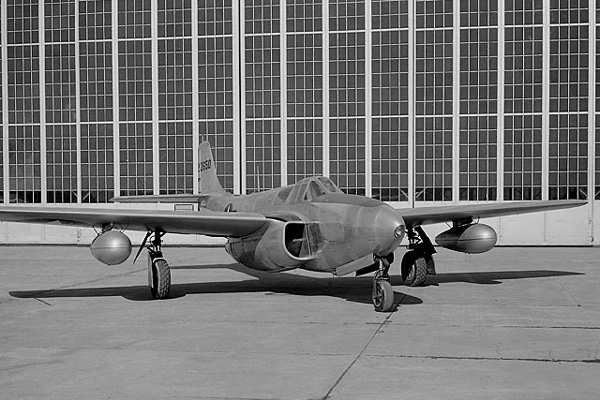
|
|
|
The Bell P-59 Airacomet was the first American jet-powered airplane in the United States. It was a top secret project that wasn't announced to the general public until 1943 and only after it had completed one-hundred flights. However, even before the Airacomet made it onto the drawing board, Europe already had its own jet programs well underway. Germany's Messerschmitt Me 262, Arado Ar 234, and England's Gloster Meteor would all become operational during the war. In the Pacific, the Japanese also flew the Nakajima Kikka at least once, powered by an Ishikawajima Ne-20, Japan's first turbojet engine. Germany was the first country to get a jet-powered plane off the ground, beginning with the Heinkel 178. The first official flight was on August 27, 1939, powered by the HeS 3 centrifugal turbojet designed by Otto Von Ohain.1 (There were three earlier test hops on the 24th.) Despite the advancement in technology, these aircraft would be too new and too late to have any measurable effect on the war. It would take several more years to develop the full potential of the jet airplane. | |
| The P-59 had its inception on August 28, 1941, after Lawrence Bell, President of Bell Aircraft, was summoned to Washington, DC for a conference. He had been called to the nation's capital by General Henry "Hap" Arnold, Commanding General of the US Army Air Force to discuss the possibility of designing a single-seat jet fighter utilizing General Electric's A-1 centrifugal turbojet engine. The A-1 was an American version of the Power Jets W.1 turbojet that had been developed by Frank Whittle. General Arnold was given, the plans for the aircraft's powerplant after attending a demonstration of the Gloster E.28/39 in April 1941.2 Bell Aircraft was chosen as the designer, because it was less overloaded by aircraft production, its close proximity to GE and Bell was also noted for advanced aircraft designs.3 Larry Bell accepted the offer and a contract was signed on September 30, 1941. Bell then put his engineers to work on the Model 27 as it was known inside the company. |
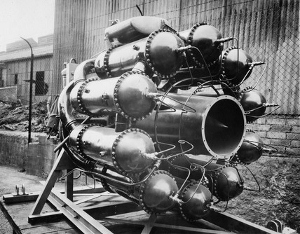 The Power Jets W.1 centrifugal turbojet. |
| The Airacomet was described as radical in design, but only because it was jet powered. Other than the engine, the airplane’s design was quite conventional and its performance left much to be desired. It had the Bell trademark tricycle landing gear, a straight cantilever mid-wing of relatively low aspect ratio and conventional tail unit. The fuselage was a flush riveted monocoque construction with electric flaps and fabric covered control surfaces. The cockpit was pressurized and heated with engine bleed air. |
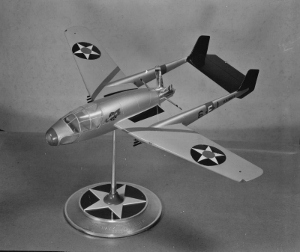 A model of the original XP-59. |
At the time, the Bell Company was working on a new fighter with contra-rotating propellers in a pusher configuration for the Air Force under the designation, XP-59. In order to preserve the cloak of secrecy, the original project was canceled and the new twin jet fighter was given the same designation. The new jet fighter design was approved on January 9, 1942 and construction began in March 1942 on three XP-59A prototypes.4
Absolute secrecy was required for the XP-59A and Bell engineers were moved to a former Pierce-Arrow automobile factory in downtown Buffalo. Production was later moved to the second floor of a three-story building, where a machine shop took the place of a Ford car agency. The building's windows were welded shut and the glass painted over. Guards were placed around the building on 24-hour watch. |
| The first jet engine arrived in Buffalo on August 4, 1942, and the first XP-59A was ready for shipment on September 10. To extract the airplane from the building, workmen had to knock a large hole in the side of the brick building, after which three large crates were lowered onto two railroad flat cars. To assure that the bearings in the engines would not be damaged by the vibrations during transport, an air compressor was hooked up to pump air to the engines to rotate the turbines. | |
| The XP-59A would be powered by two General Electric I-A, centrifugal turbojets with a statutory thrust of 1,250 lbs. On September 12, 1942, the first XP-59A was sent to Muroc Army Air Field in California for testing where it was flown for the first time on October 2, 1942 by Robert Stanley, Bell's chief test pilot. Flight evaluation uncovered a multitude of problems as the XP-59A tended to yaw and sway. Other problems were poor engine response and insufficient lateral stability during rolls. |
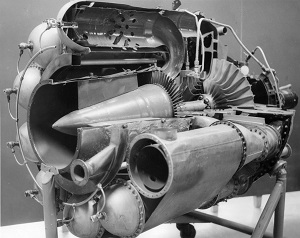 The General Electric A-1 centrifugal turbojet. The I-A would later change to I-16. The military designation was J-31. |
|
On March 26, 1943, thirteen pre-production YP-59As were ordered. The YP-59A would essentially be the same as the three X models, except that it would have a sliding canopy instead of being hinged. The first two YP-59As were delivered to Muroc in June 1943.
The thirteen service test YP-59As had a more powerful engine than its predecessor, but the improvement in performance was negligible with only a five mph increase in top speed. The third YP-59A built was supplied to the Royal Air Force (RAF) in exchange for the first production Gloster Meteor I. British pilots found that the YP-59A performance was unsatisfactory when compared to the Meteor. The Airacomet flew only eleven times at Farnborough and it was returned to the United States in early 1945.

For the purpose of secrecy, the aircraft was disguised with a wooden propeller.
While the performance of the Airacomet was not spectacular, one YP-59A did establish a new unofficial altitude record of 47,600 feet. The first YP-59As were powered with the earlier I-12 (GE A-1) with engines providing 1,250 lb. thrust and eventually the I-16 (J31-GE-3) providing 1,650 lb. thrust. Later production models of the P-59B-1-BEs were powered with J31-GE-5 engines of 2,000 lbs. thrust. On March 11, 1944, a contract was signed for 100 P-59A-BEs and a further 250 were planned. The production model had a shortened wing and all control surfaces were metal covered. The fuselage was strengthened and the tail was redesigned, incorporating a ventral fin. However, the contract was canceled after only thirty-nine aircraft were delivered, plus the additional aircraft on the assembly line, for a total of fifty aircraft. The total production was broken down into two batches of 20 P-59A-BEs and 30 P-59B-1-BEs. The B model differed by adding 66 gallon wing tanks.
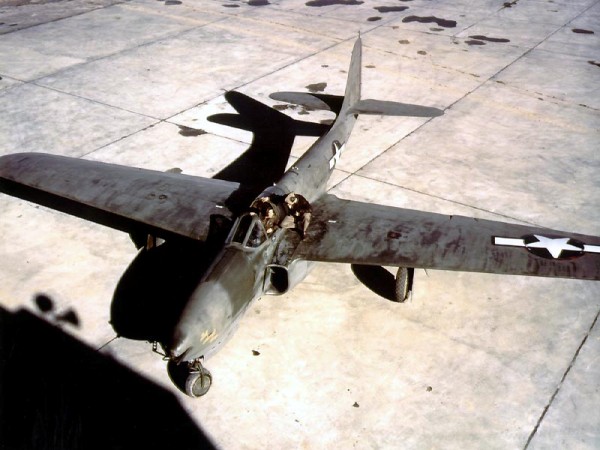
Mock combat sorties were conducted against the P-59 with a Lockheed P-38 Lightning and Republic P-47 Thunderbolt and in March 1945 against a captured Mitsubishi Zero. It was discovered that the P-59 was outclassed by the current piston-engine fighters and it offered no appreciable advantage over conventional aircraft.
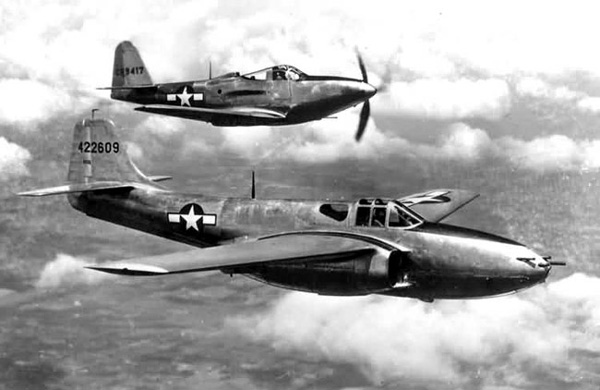
A P-59A Airacomet with a P-63 Kingcobra flying as escort. Most of the P-59s went the 412th Fighter Group of the Fourth Air Force at Muroc AFB, but unlike the Messerschmitt Me-262 and the Gloster Meteor, the P-59 was only useful as a test vehicle and as a jet trainer and no Airacomets ever entered wartime service. A few P-59s were later modified as drone directors and manned target aircraft, with a second cockpit installed forward of the of the pilot's cockpit. A proposal was requested for Bell to produce an XP-59B version, which would have been powered by a single turbojet engine, where air was fed through inlets at the wing roots and exhausted beneath the fuselage. Bell declined the offer and the proposal was taken up by Lockheed which developed the Lockheed P-80 Shooting Star.5 Although the P-59 did not contribute to the war effort, it was a window into the future of outstanding American jet aircraft that were just on the horizon. | |

The initial XP-59A Airacomet design team. (Photo: James Wolf Kinzer)
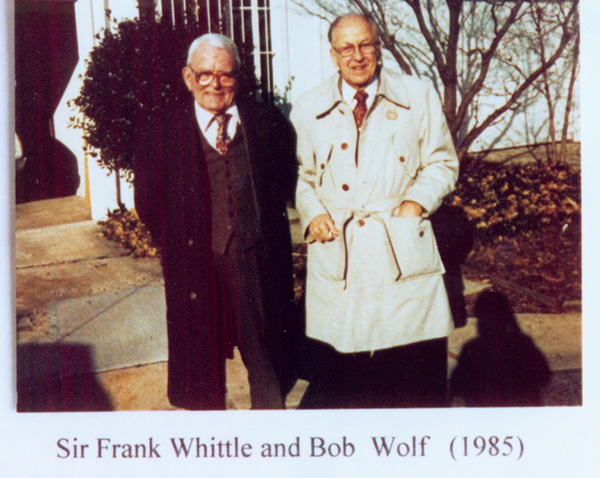
Bob Wolf had responsibility for the power plant and frame design. (Photo: James Wolf Kinzer) |
| Specifications: | |||
|---|---|---|---|
| Bell P-59 Airacomet | |||
| Dimensions: | |||
| XP-59A | P-59A | P-59B | |
| Wing span: | 45 ft 6 in (13.87 m) | 45 ft 6 in (13.87 m) | 45 ft 6 in (13.87 m) |
| Length: | 38 ft 2 in (11.63 m) | 38 ft 10 in (11.84 m) | 38 ft 10 in (11.84 m) |
| Height: | 12 ft 4 in (3.76 m) | 12 ft 0 in (3.66 m) | 12 ft 4 in (3.76 m) |
| Weights: | |||
| Empty: | 7,320 lb (3,320 kg) | 7,950 lb (3,606 kg) | 8,165 lb (3,704 kg) |
| Max T/O Weight: | 12,562 lb (5,698 kg) | 13,000 lb (5,897 kg) | 13,700 lb (6,214 kg) |
| Performance: | |||
| Maximum Speed: | 404 mph (650 km/h) @ 25,000 ft (7,620 m) |
413 mph (665 km/h) @ 30,000 ft (9,144 m) |
413 mph (665 km/h) @ 30,000 ft (9,144 m) |
| Service Ceiling: | 45,756 ft (13,946 m)* | 46,200 ft (14,082 m) | 46,200 ft (14,082 m) |
| Normal Fuel: | 570 U.S. gal (2,157 l) | 290 U.S. gal (1,098 l) | 356 U.S. gal (1,347 l) |
| Maximum Fuel: | 870 U.S. gal (3,293 l) | 590 U.S. gal (2,233 l) | 656 U.S. gal (2,483 l) |
| Normal Range: | 375 miles (604 km) | 375 miles (604 km) | |
| Maximum Range: | 550 miles (885 km) | 950 miles (1,529 km) | Powerplant: | Two General Electric I-A 1,250 lb (567 kg) s.t., centrifugal turbojet engines. |
Two General Electric J-31-GE-3 1,650 lb (748 kg) s.t., centrifugal turbojet engines. |
Two General Electric J-31-GE-5 2,000 lb (907 kg) s.t., centrifugal turbojet engines. |
| Armament: | Two 37 mm cannons. | One 37 mm cannons or three 0.50 cal mg. 2,000 lb (907 kg) bombs or 8 x 60 lb. (27 kg) rockets. | One 37 mm cannons or three 0.50 cal mg. 2,000 lb (907 kg) bombs or 8 x 60 lb. (27 kg) rockets. |
| * Absolute ceiling. | |||
Endnotes:
|
1. John Golley. Genesis Of the Jet, Frank Whittle and the Invention of the Jet Engine. Shrewsbury, England. Airlife Publishing Ltd., 1997. 80. 2. Enzo Angelucci and Peter Bowers. The American Fighter. Sparkford, England: Haynes Publishing Group, 1987. 48. 3. Robert Jackson. F-86 Sabre, The Operational Record. Shrewsbury, England: Airlife Publishing, 1994. 1. 4. Alain J. Pelletier. Bell Aircraft Since 1935. Annapolis, Maryland: Naval Institute Press, 1992. 52. 5. Lloyd S. Jones. U.S. Fighters, Army Air Force 1925 to 1980s. Fallbrook California: Aero Publishers Inc., 1980. 154.
© Larry Dwyer The Aviation History Online Museum. All rights reserved. |